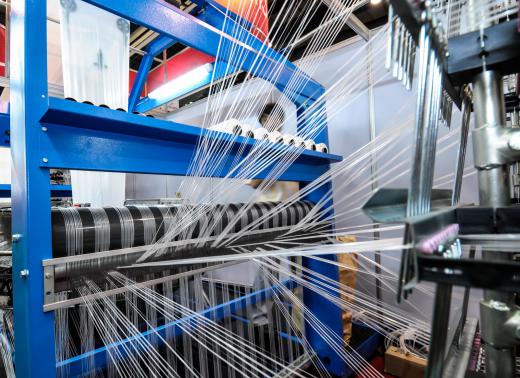Acquiring the best power loom depends on the requirements of the weaver, as machines differ in cost, size, and degree of automation. Weavers hoping to increase quantity must also consider the manufacturing rates of various machines. Air or water jet looms provide the greatest amount of production in the least amount of time. Regardless of automated features, all power looms require manual interaction on some level, including warping, or threading, the machine.
If you are planning to start a small business venture, your budget allowance may determine the type and size of power looms available. New commercial weaving machines typically cost hundreds of thousands of dollars. The benefits of buying a new power loom include the fact that some companies manufacture custom machinery, built to the buyer's specifications. Manufacturers often offer extended maintenance of and training on the machine. You might, however, find a better deal from companies that are upgrading their equipment or from manufacturers that are discontinuing business and are willing to sell current models of power looms at a significantly reduced price, often a fraction of the cost of new machinery.

Size might be another factor when looking to purchase the best power loom. While some automated machines require about the same amount of floor space as larger conventional looms, other models can occupy more than 400 square feet (37 square meters) of working space. While all power looms operate off standard household current, they differ in the amount of automation. Some industrial machines used for weaving textiles have sensors that alert personnel when yarns break or shuttle mechanisms go awry. Other models may not be equipped with these features.

Individual power looms also require varying amounts of human interaction concerning set-up and operation. Some automated power looms, though electronic, require manual adjustments for the type and amount of fabric produced. A computer operated power loom merely requires the weaver to chose the desired settings using the accompanying software. The power loom then creates the desired pattern and amount of fabric according to specifications. Depending on the specific system, each power loom might have an individual command station while a mainframe monitors productivity and maintains databases on all of the looms.
Different types of power looms also vary in the speed with which they produce fabric. While Jacquard power looms allow individual thread control and can create complex patterns with ease, it produces only around 500 picks, or rows, per minute. Faster machines include the rapier power loom, which uses flexible coiled rapiers, in place of shuttles, that function together to create the horizontal row of threads known as the weft. This loom produces fabric at the rate of around 850 picks per minute. Many believe a rapier air jet surpasses the production potential of most power looms with its ability to create up to 1,200 picks per minute, by propelling the rapiers across the machine using an initial and additional bursts of air.
